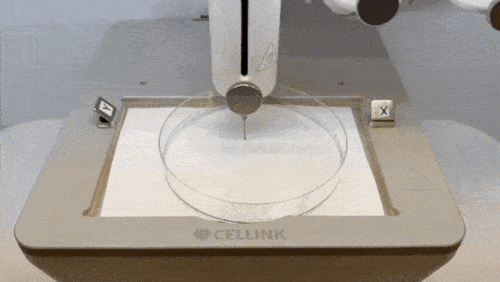Researchers at the University of Waterloo have developed an environmentally friendly 3D-printing ink that has opened up the possibilities of graphene in a variety of fields, including consumer electronics, automobiles, and environmental cleanup. The study was published in the Journal of Materials Chemistry A.
 A 3D printer uses the graphene ink to make a UW logo. Image Credit: University of Waterloo
A 3D printer uses the graphene ink to make a UW logo. Image Credit: University of Waterloo
Although graphene is widely recognized for its strength, electrical conductivity, and thermal characteristics, its applications are limited because it is usually produced as a powder that can be challenging to work with.
By designing graphene nanosheets that can disperse in water while retaining conductivity, researchers at Waterloo addressed that issue and produced the first all-graphene ink in history.
However, it does not contain any additives or require any chemical solvents to print; the new ink is incredibly versatile and environmentally friendly.
Shaping graphitic materials into complex geometries for advanced applications has long been a critical challenge that has limited their widespread adoption. With our proposed methods, we can 3D-print graphene into any shape.
Dr. Milad Kamkar, Professor, Department of Chemical Engineering, University of Waterloo
Graphene is a water-based, functional ink that can be used with 3D printers to create glucose monitoring for diabetics or sensors for fitness bands and smartwatches.
Additional possible uses include filters to purify and even desalinate water and 3D-printed parts to make cars lighter, lowering fuel consumption while increasing durability.
Batteries, printed electronics, and environmental remediation including cleaning up oil spills in oceans with porous, super-absorbent structures and absorbing carbon dioxide in the atmosphere to slow down climate change could all benefit from graphene ink.
The research team, which included representatives from the University of British Columbia, the University of Calgary, and Aalto University in Finland, created these inks using a two-step electrochemical process that works well for mass production.
Continuous generation of graphene nanosheets in water is made possible by a specially engineered process known as intercalation, which entails inserting a molecule into layered graphite.
Our modern technological advancements have come at the cost of new environmental challenges. To survive and address these challenges, we must develop new materials that are more effective than those currently available. This can only be achieved by controlling and fine-tuning material properties across multiple scales, from the molecular and nano levels to the macro scale.
Dr. Milad Kamkar, Professor, Department of Chemical Engineering, University of Waterloo
Kamkar is also the Director of the Multiscale Materials Design Lab at Waterloo.
Investigating cutting-edge uses for carbon dioxide capture and environmental remediation technology will be the researchers' next tasks.
Journal Reference:
Erfanian, E., et al. (2024) Additive-free graphene-based inks for 3D printing functional conductive aerogels. Journal of Materials Chemistry A. doi.org/10.1039/d4ta03082f.